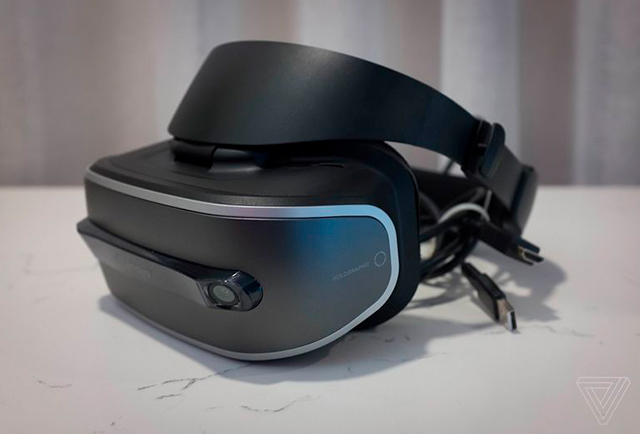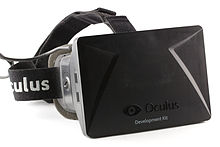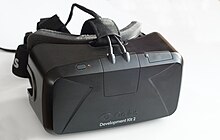Vr Prototype X5

Initial prototypes
Through Meant to be Seen (MTBS)’s virtual reality and 3D discussion forums,[11] Palmer Luckey, the founder of Oculus and longtime MTBS discussion forum moderator,[12] developed the idea of creating a new head-mounted display that was both more effective than what was then on the market, and inexpensive for gamers.
The first rough prototype was hacked together in 2011 by Palmer Luckey (then 18 years old) in his parents’ garage in Long Beach, California.[13] Coincidentally, John Carmack had been doing his own research and happened upon Luckey’s developments as a fellow member of MTBS.[14] After sampling an early prototype, Carmack favored Luckey’s approach and just before the 2012 Electronic Entertainment Expo, Id Software announced that their future updated version of Doom 3, BFG Edition, would be compatible with head-mounted display units.[15]
In June 2012, during the E3 convention, Carmack introduced a duct taped head-mounted display based on Luckey’s Oculus Rift prototype, which ran Carmack’s own software. The unit featured a high speed IMU and a 5.6-inch (14 cm) LCD, visible via dual lenses, that were positioned over the eyes to provide a 90 degrees horizontal and 110 degrees vertical stereoscopic 3D perspective.[16][17]
Development Kit 1
Two months after being formed as a company, Palmer’s Oculus VR launched a Kickstarter crowdfunding campaign on August 1 of 2012 for their virtual reality headset, which was named the Rift. The main purpose of the kickstarter was to get an Oculus Rift prototype—now referred to as DK1 (Development Kit 1)—into the hands of developers to begin integration of the device into their games.[18][6] DK1 was given as a reward to backers who pledged $300 or more on Kickstarter, and was later sold publicly for $300 on their website. These kits sold at a rate of 4–5 per minute for the first day, before slowing down throughout the week.[19][20]
The Rift DK1 was released on March 29, 2013,[21] and used a 7-inch (18 cm) screen with a significantly lower pixel switching time than the original prototype, reducing latency and motion blur when turning one’s head quickly. The pixel fill is also better, reducing the screen door effect and making individual pixels less noticeable. The LCD was brighter and the color depth is 24 bits per pixel.
The 7-inch screen also makes the stereoscopic 3D no longer 100% overlapping, the left eye seeing extra area to the left and the right eye seeing extra area to the right. The field of view (FOV) is more than 90 degrees horizontal (110 degrees diagonal), which is more than double the FOV of previous VR devices from other companies, and is the primary strength of the device. The resolution is 1280×800 (16:10 aspect ratio), which leads to an effective of 640×800 per eye (4:5 aspect ratio). However, since the Rift does not feature a 100% overlap between the eyes, the combined horizontal resolution is effectively greater than 640. The image for each eye is shown in the panel as a barrel distorted image that is then corrected by pincushion effect created by lenses in the headset, generating a spherical-mapped image for each eye.
Initial prototypes used a Hillcrest Labs 6DoF head tracker that is normally 125 Hz, with a special firmware requested by John Carmack that makes it run at 250 Hz, tracker latency being vital due to the dependency of virtual reality’s realism on response time. The latest version includes Oculus’s new 1000 Hz Adjacent Reality Tracker, which will allow for much lower latency tracking than almost any other tracker. It uses a combination of three-axis gyros, accelerometers, and magnetometers, which make it capable of absolute (relative to Earth) head orientation tracking without drift.[22]
The Development Kit 1 also included interchangeable lenses that will allow for simple dioptric correction.
The entire source for the Rift DK1 was released to the public in September 2014, including the firmware, schematics, and mechanicals for the device. The firmware is released under a simplified BSD license, while the schematics and mechanicals are released under a Creative Commons Attribution 4.0 International License.[23]
HD and Crystal Cove prototypes
In June 2013, a prototype of the rift that used a 1080p LCD panel was shown at Electronic Entertainment Expo. This step forwards to twice the number of pixels as DK1 significantly reduced the screen door effect and made objects in the virtual world more clear, especially at a distance. The poor resolution had been the main criticism of the DK1.[24]
This HD prototype is the only prototype of the Rift shown to the public which did not turn into a publicly available developer kit.
In January 2014, an updated prototype codenamed “Crystal Cove” was unveiled at Consumer Electronics Show, which used a special low-persistence of vision OLED display as well as a new motion tracking system that utilized an external camera to track infrared dots located on the headset. The new motion tracking system would allow the system to detect actions such as leaning or crouching, which was claimed to help alleviate sickness experienced by users when the software did not respond to these actions.[25]
Development Kit 2
Oculus began shipping Development Kit 2 (DK2) in July 2014.[26] This is a small refinement of the “Crystal Cove” prototype, featuring several key improvements over the first development kit, such as having a higher-resolution (960×1080 per eye) low-persistence OLED display, higher refresh rate, positional tracking, a detachable cable, and the omission of the need for the external control box.
A teardown of DK2 revealed that it incorporates a modified Samsung Galaxy Note 3 smartphone display, including the front panel from the device itself.[27]
In February 2015, Oculus announced that over 100,000 DK2 units had been shipped up until that point.[28]




